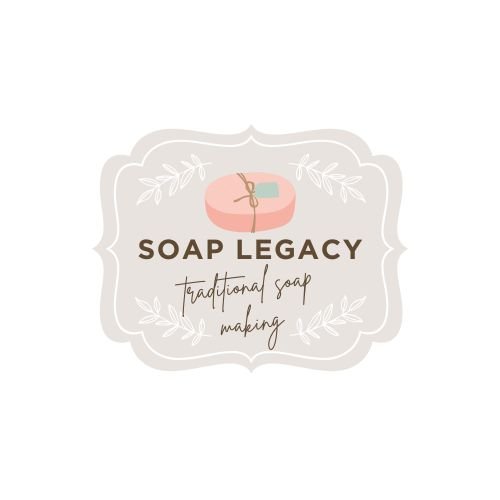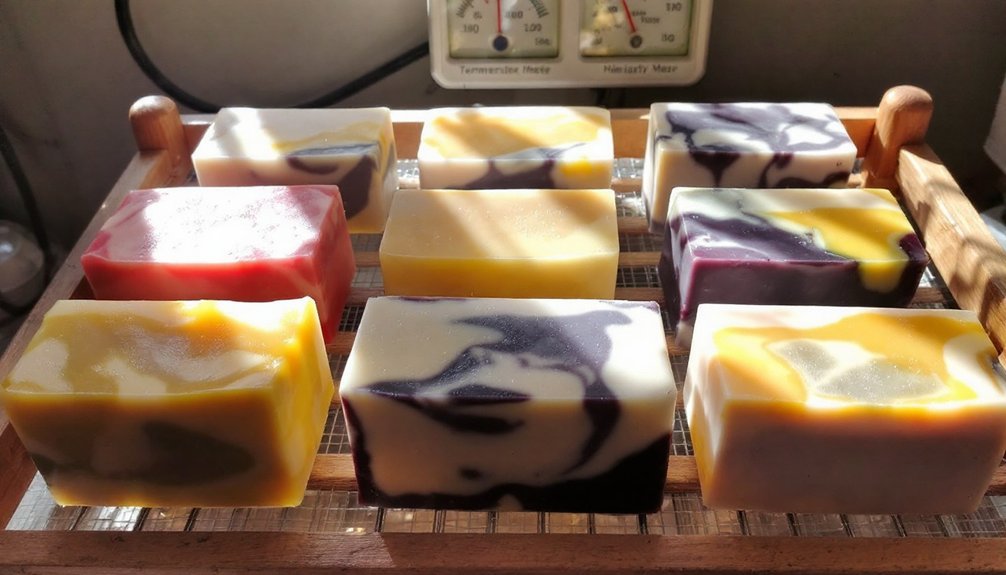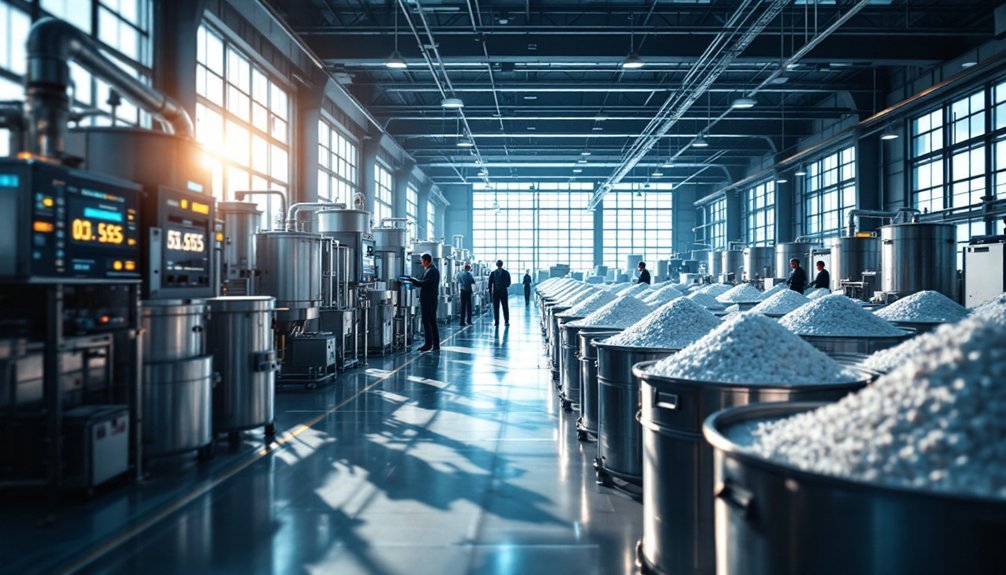Your soap bars can cure unevenly when temperature, humidity, and air circulation aren't properly controlled during the drying process. If you're exposing your bars to temperatures below 60°F or humidity above 70%, you'll notice patchy results. Improper ingredient ratios, contaminated storage surfaces, and batch size variations can also disrupt even curing. Poor ventilation and inconsistent room conditions will affect your final product's quality. Understanding these factors will help you achieve perfectly cured bars every time.
Understanding the Chemistry Behind Soap Curing

When you explore the chemistry of soap curing, you'll find that saponification lies at its heart. This chemical reaction occurs when your fats or oils combine with an alkali like lye, producing both glycerin and soap. If you don't properly balance these ingredients, you'll end up with uneven curing throughout your bars.
Temperature and humidity greatly influence how your soap cures. Higher temperatures speed up saponification, while cooler conditions slow it down.
You'll also need to take into account your choice of oils carefully, as each has its own saponification value and curing time. When you're mixing ingredients, make sure they're thoroughly blended – any inconsistencies can create pockets where lye or oils concentrate.
Similarly, if you're adding fragrances or colorants, distribute them evenly to prevent interference with the saponification process.
Common Temperature and Humidity Effects

Because temperature and humidity play essential roles in soap curing, you'll need to monitor these conditions carefully throughout the process.
When temperatures drop below 60°F, your bars will cure more slowly and may develop uneven patches. Similarly, high humidity can trap moisture within your soap, causing cloudy spots and inconsistent results.
You'll achieve the best results when curing your bars between 70°F and 90°F, as this range promotes uniform drying and a smooth finish.
Pay attention to how thick you pour your soap, as varying thickness can compound temperature-related issues. Thicker sections might remain soft while thinner areas cure too quickly.
Remember that each soap formula has specific temperature and humidity requirements. If you don't stay within these parameters, you're likely to encounter problems like soft spots and wavy textures.
Proper Air Circulation Requirements

You'll need to set up cross-ventilation by positioning fans strategically across your workspace while maintaining a steady room temperature between 70-75°F for ideal epoxy curing.
Your air circulation system should include both intake and exhaust points to create a gentle, consistent flow that won't disturb the curing surface but will prevent stagnant air pockets from forming.
To control humidity levels, you can incorporate a dehumidifier into your ventilation setup, keeping moisture levels in check while ensuring proper air movement throughout the curing process.
Cross-Ventilation Setup Basics
To achieve consistent epoxy curing across your bars, proper cross-ventilation setup remains crucial for maintaining uniform temperatures and ideal humidity levels. You'll need to strategically position fans to create a continuous airflow path while avoiding any stagnant pockets. Make certain you're keeping humidity between 50-70% and protecting your workspace from sudden drafts that could cause uneven curing.
| Setup Component | Purpose |
|---|---|
| Intake Fan | Brings fresh air into workspace |
| Exhaust Fan | Removes heat and excess moisture |
| Air Flow Path | Creates consistent circulation pattern |
| Draft Barriers | Prevents temperature fluctuations |
| Humidity Monitor | Maintains optimal moisture levels |
Set up your exhaust and intake fans on opposite sides of your workspace to promote effective heat dissipation during the exothermic curing process. This systematic approach guarantees your bars will cure uniformly throughout.
Room Temperature Air Flow
Although proper ventilation forms the foundation of your epoxy workspace, maintaining precise room temperature airflow plays an equally essential role in achieving consistent cures.
You'll want to keep your room between 70-75 degrees Fahrenheit while ensuring steady air movement throughout your work area.
Set up a fan to promote uniform air circulation, but be strategic about its placement. Don't position it where it'll create direct drafts on your epoxy surface.
You'll also need to avoid placing your projects near windows or HVAC vents, as these areas can create temperature fluctuations that lead to uneven curing.
Keep an eye on your humidity levels too – high moisture content in the air can interfere with proper hardening and create texture issues in your finished bars.
Humidity Control Methods
Maintaining the right humidity levels and air circulation creates the perfect environment for your epoxy to cure evenly.
You'll want to keep humidity between 40% and 60% to prevent surface imperfections and guarantee uniform hardening throughout your bars.
To achieve ideal conditions, you'll need to take active control of your workspace.
Install fans to prevent air stagnation and use dehumidifiers when necessary to regulate moisture levels.
Don't let your bars cure in enclosed spaces without proper ventilation, as trapped humidity can create soft spots and compromise the final product.
Keep a hygrometer handy to monitor environmental conditions – it's your best tool for making quick adjustments when needed.
Storage Surface Material Impact

When working with epoxy bars, your choice of storage surface material plays a vital role in achieving uniform curing results. You'll find that non-absorbent surfaces like plastic or metal can trap heat, leading to uneven curing patterns, while absorbent materials like wood help maintain stable temperatures throughout the process.
| Surface Type | Impact on Curing |
|---|---|
| Wood | Stabilizes temperature, promotes even curing |
| Plastic | May trap heat, causes uneven distribution |
| Metal | Can create temperature fluctuations |
| Contaminated | Interferes with chemical bonding |
| Uneven | Creates pooling and thickness variations |
If you're working in a cold environment, your surface material choice becomes even more essential. Some materials won't maintain consistent temperatures, which can compromise your final product. Always verify your surface is clean, level, and compatible with epoxy to avoid adhesion issues and irregular curing patterns.
Batch Size and Bar Thickness Variables

Beyond storage surface considerations, the size and thickness of your epoxy bars directly influence their curing behavior. When you're working with larger batches, you'll need to manage heat buildup carefully, as excessive heat can cause uneven hardening throughout your bars.
If you're creating thicker bars, you'll face additional challenges. The thickness can trap both heat and moisture, leading to a situation where the outer edges cure faster than the center.
You'll also notice that cooler temperatures affect thicker sections more considerably, slowing down the curing reaction. Pay close attention to your mixing ratios, as variations can result in inconsistent curing rates across different areas.
Temperature control and precise mixing ratios are critical when working with thick epoxy sections to ensure consistent, proper curing throughout.
When working with thicker bars, make sure your curing agent is thoroughly distributed to prevent soft or uncured spots.
Essential Oil and Fragrance Influences
Adding essential oils and fragrances to your epoxy bars requires careful consideration, as these additives can greatly impact the curing process. When you introduce these elements, they can interfere with the chemical reactions that make your epoxy harden properly.
You'll need to watch out for moisture and contaminants that fragrances might bring, as they can create soft spots or prevent complete hardening. The varying viscosities and evaporation rates of different essential oils will affect how your bars cure, potentially leading to texture inconsistencies.
If your fragrances contain solvents, they'll disrupt the epoxy's cross-linking process, causing sections to cure at different speeds.
Before using any essential oils or fragrances in your full batch, you should always test a small sample first to verify they're compatible with your epoxy system.
Water Content and Saponification Balance
The delicate balance between water content and saponification plays an essential role in achieving uniformly cured epoxy bars. If you're experiencing uneven curing, it's likely due to moisture interference with the chemical reactions or improper mixing ratios. You'll need to maintain strict control over these factors to guarantee success.
| Factor | Impact | Solution |
|---|---|---|
| Water Content | Disrupts curing reactions | Control humidity levels |
| Mixing Ratio | Affects saponification | Follow 2:1 ratio precisely |
| Temperature | Influences curing speed | Maintain stable environment |
| Contaminants | Interferes with bonds | Clean workspace thoroughly |
| Balance | Determines final hardness | Measure ingredients exactly |
Remember that temperature stability is essential throughout the process, as fluctuations can affect both water content and saponification. You'll want to avoid any oils or dust that could compromise your mixture's integrity and prevent proper curing.
Curing Room Setup and Maintenance
You'll need to maintain a consistent temperature of 70 degrees Fahrenheit and humidity below 50% in your curing room to prevent uneven results in your bars.
Your climate control equipment should be regularly calibrated and monitored to guarantee these ideal conditions remain stable throughout the entire curing period.
Proper storage solutions, including well-ventilated shelving units and clean, dust-free surfaces, will help protect your bars from environmental contaminants that can interfere with the curing process.
Climate Control Essentials
Because creating pristine epoxy bars requires precise environmental conditions, setting up a well-controlled curing room is essential for consistent results. You'll need to maintain temperatures between 70-75°F and keep humidity levels under 60% to prevent soft spots and uneven hardening. Using dehumidifiers and air conditioning can help you achieve these ideal conditions, especially in warm, humid climates.
| Climate Factor | Control Method |
|---|---|
| Temperature | HVAC system/heater |
| Humidity | Dehumidifier/AC |
| Air Quality | Ventilation fans |
Don't forget to monitor your curing room conditions regularly. Proper ventilation isn't just about removing fumes—it helps maintain a stable environment that promotes even curing. By staying vigilant with these climate controls, you'll minimize the risk of waviness and uncured sections in your final product.
Optimal Storage Solutions
Setting up your curing room properly extends beyond basic climate control – it's a dedicated workspace that demands careful organization and maintenance.
You'll need to create an environment that's both clean and functional, with proper ventilation systems to prevent fume buildup and moisture accumulation. Installing a dehumidifier will help you maintain ideal humidity levels, preventing those frustrating soft spots in your bars.
- Position your storage racks away from windows and doors to maintain consistent temperatures between 70-75°F
- Keep cleaning supplies readily available to quickly remove any dust or debris that could compromise your bars' finish
- Install adequate lighting throughout the space to help you spot potential issues and monitor the curing process effectively
Remember to regularly check and adjust your room's conditions for the best possible results.
Frequently Asked Questions
How to Fix Uneven Epoxy?
You'll need to scrape off uncured epoxy, sand the surface, and clean thoroughly. Mix new epoxy properly and re-pour over the affected areas. For widespread issues, consider re-pouring the entire surface.
Why Is My Resin Not Fully Curing?
Your resin isn't fully curing because you've likely mixed incorrect ratios, worked in low temperatures, applied uneven thickness, allowed surface contamination, or haven't mixed thoroughly enough. These factors disrupt proper chemical reactions.
How to Fix Bumpy Resin?
First, scrape bumpy areas with a putty knife to remove uncured epoxy. Clean with paper towels, then sand until smooth. You'll need to pour a fresh layer of well-mixed resin for a perfect finish.
How to Fix Ripples in Resin?
To fix resin ripples, you'll need to scrape the area with a putty knife, sand it smooth, clean thoroughly, and re-pour with self-leveling epoxy. Monitor temperature and mixing ratios carefully during application.
In Summary
You'll find uneven curing of your soap bars typically stems from multiple factors within your control. By maintaining consistent temperature, proper air circulation, and balanced humidity levels, you can prevent most issues. Watch your water ratios, guarantee even bar thickness, and use appropriate storage surfaces. If you're still seeing problems, check your essential oil percentages and adjust your curing room setup accordingly.





Leave a Reply